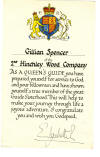Guiding in Hinchley Wood has been “flying high” since the first unit started back in 1936. Guiding has always been about instilling girls with useful skills, confidence and a sense of adventure. It is as much about individual achievement as it is about working together in a team. It encourages girls and young women to try new things, as well as gives them the confidence and the tools to achieve their goals.

The Queen’s Guide award is the highest award in Guiding. 51 Guides in Hinchley Wood achieved their Queen’s Guide between 1953 and 1984. There is a plaque up at our headquarters with the names of those who achieved the ward click here to see the list
Queens guides . Many a newspaper article was written about them. Lots of badges, and certificates were awarded and lots of slices of cake were eaten in celebration!
About the
Queen’s Guide Award
In 1946 the
Queen’s Guide Badge was instituted as the highest test work achievement for
Guides under the age of 17 and then for under-16s.
At this time you
could become a Queen’s guide and have the honour of wearing the Queen’s
Guide Badge on your uniform if you; took part in the Promise-centred Eight
Point Programme of your Patrol and your Company for at least two years.
Made sufficient progress in each of the Eight Points and were awarded
two Eight Point Badges by your Patrol Leader’s Council.
You also had to gain several interest badges including: The Little
House Emblem and Camper Badge and one other badge from the Woodcraft Emblem
for example the Backwoodsman badge, or the Woodcraft Emblem or Patrol Camp
Permit and two badges from the Little House emblem.
You then had to choose three further badges to complete, one taken
from the Fitness Emblem (for example cyclist) and one from the Arts and
Craft Emblem (for example artist), and one from the World Friendship Emblem
(for example Interpreter).
You also had to prepare yourself to
give service in the community through gaining the Service Emblem. The
following badges were required to gain this Emblem: Emergency Helper, First
Aid, Accident Prevention, Fire-fighter, Pathfinder (pointing finger),
Map-reader. (The Emergency Helper and First Aid badge had to be renewed
every two years.). You then had
to complete this service in the community by carrying out a continuous piece
of personal service to others for 4 months or 40 hours in a 12-month period.
You would then gain your service flash.
Finally you had to increase your knowledge of the Commonwealth or the
World by gaining the Commonwealth Badge or the World Friendship Badge.

I
n order to keep wearing the Queen’s Guide Badge after you had gained it, you had to keep your knowledge up to date and continue to be of service by renewing your Service Flash annually. You could go on to complete the requirements for the Queen’s Guide in the Ranger Guide service section provided you did so before your sixteenth birthday.
The Queen’s
Guide Badge was revised from 1981 to 1983, and at that point was made
available solely for girls between 16 and 19.
Nowadays the age bracket for this award is 16-25.
Candidates for this challenging award are not allowed to start before
their 16th birthday and have three years to complete a number of
challenges in five different areas; Service in Guiding, Community Action,
Personal Skill Development, Outdoor Challenge, and Residential Experience.

A silver brooch
replaced the fabric badge in 1983, and was to be presented with a
certificate from the Queen.
Princess Margaret presented the first 50 brooches at Kensington Palace in
1986.
book mark

